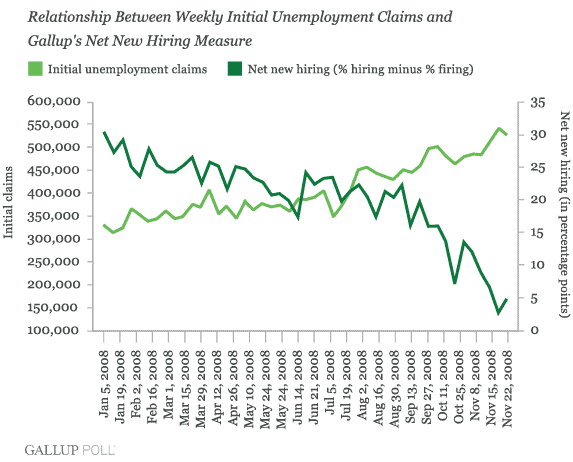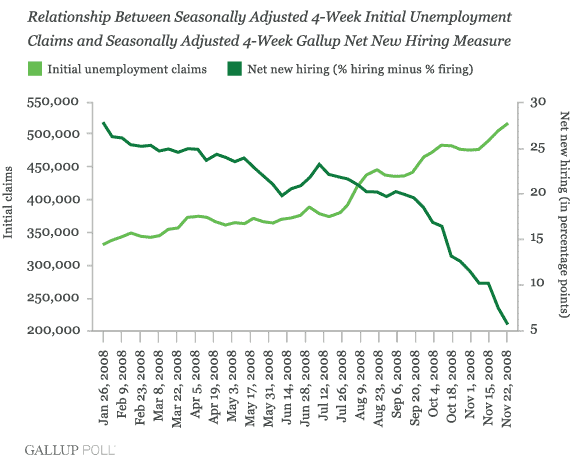PRINCETON, NJ -- Contrary to the consensus estimate of economists' expectations, Gallup's hiring measure shows U.S. employees' perceptions of the job situation at their companies improved a little last week. This suggests that Thursday's Labor Department report of first-time unemployment claims for the week ending Nov. 29 may well have increased less than the 529,000 reported last week -- in the opposite direction of the consensus estimate increase to 540,000.

Anticipating Jobless Claims
As the newly acknowledged economic recession deepens, weekly reports of seasonally adjusted new unemployment claims have morphed into something of a leading economic indicator. As always, they reflect the slowing of the economy that has already taken place, but today, they also tend to suggest even weaker economic activity in the weeks ahead as a more traditional unemployment-driven recession takes hold. As a result, the direction of weekly jobless claims takes on even more importance than it has had in the past.
Using weekly results for 2008, Gallup's analysis suggests that its hiring measure has a better than 7-in-10 probability of correctly projecting the direction of weekly jobless claims. Gallup's hiring measure is based on aggregated interviews with a nationally representative sample of more than 2,000 U.S. workers each week. Gallup asks current full- and part-time employees whether their employers are hiring new people and expanding the size of their workforces, not changing the size of their workforces, or letting people go and reducing the size of their workforces.
Gallup calculates its Net New Hiring Activity measure by subtracting the "letting go and reducing" percentage from the "hiring and expanding" percentage. The assumption is that employees across the country have a good feel for what's happening in their companies, and that these insider perceptions can yield a meaningful indication of the nation's job situation.
While a number of variables make it hard to predict the exact number of new unemployment claims the Labor Department will report on Thursday morning, Gallup figures suggest jobless claims will be less than the 529,000 reported last week. Net new hiring (the percentage hiring minus the percentage letting go) improved from 3.0 in the week ending Nov. 16 and 5.7 in the week ending Nov. 23 to 6.9 in the week ending Nov. 30 -- resulting in Gallup's projection of slightly lower weekly jobless claims.
Before one gets too excited about the potential that the government's figures will be more positive than expected, it should be recognized that weekly changes in jobless claims tend to be somewhat volatile because they are subject to all kinds of immediate-term events such as the Thanksgiving holiday. For example, the most recent slight decline in jobless claims could reflect special hiring for this past "Black Friday" that are not fully reflected by seasonal adjustments.
A more stable indicator of the job market is the seasonally adjusted four-week average of jobless claims. The seasonally adjusted four-week average of Gallup's hiring measure has a better than 8-in-10 probability of predicting the future direction of the government's similarly calculated measure, and it suggests that the government's seasonally adjusted four-week measure continued to increase during the week that ended Nov. 29. That is, despite the slight improvement in jobless claims in each of the past two weeks, the seasonally adjusted four-week moving averages indicate that job losses will be higher in Friday's report for the month of November than they were in October.

Lagged Effects
On Monday, the National Bureau of Economic Research declared that the United States has been in a recession for the past year, while Federal Reserve Board Chairman Ben Bernanke and Treasury Secretary Henry Paulson both seemed to acknowledge that the economy will continue to be weak for some months ahead. These assessments are no surprise given the highly negative state of Gallup's consumer confidence measures. And weak Christmas sales are not likely to help the situation.
Still, the amazing speed with which the global economy is plunging suggests that the full effect of the next stage of the current economic downturn is yet to be realized on Main Street. It is essential that the new Congress and the Obama administration take aggressive actions immediately upon taking office and begin rebuilding consumer and business confidence. In this regard, it was encouraging to see President-elect Obama name his economic team last week in three days of press conferences and step into the economic leadership vacuum that has been plaguing the markets, businesses, and consumers.
How much the president-elect and his economic team can do to start rebuilding consumer confidence prior to his inauguration remains unclear. Gallup's Daily economic tracking will provide a continuous monitoring of the success of any such efforts.
Survey Methods
Gallup's Net New Hiring Activity measure was initiated in January 2008. It is an effort to assess U.S. job creation or elimination based on the self-reports of more than 2,000 individual employees aggregated each week about hiring and firing activity at their workplaces. For results based on these samples, the maximum margin of sampling error is ±3 percentage point.
Interviews are conducted with respondents on land-line telephones (for respondents with a land-line telephone) and cellular phones (for respondents who are cell-phone only).
In addition to sampling error, question wording and practical difficulties in conducting surveys can introduce error or bias into the findings of public opinion polls.
